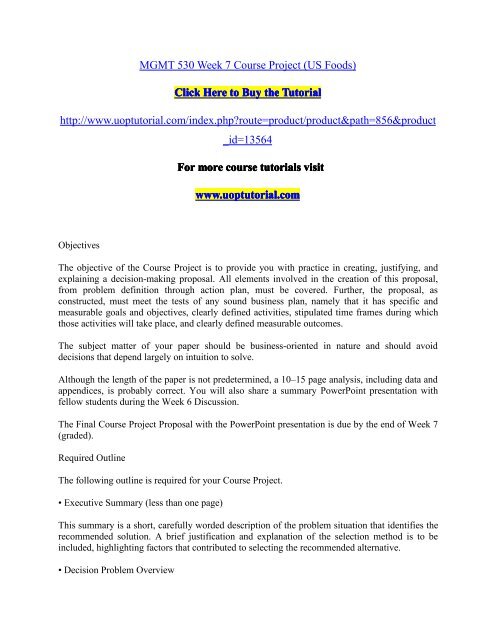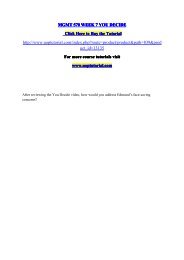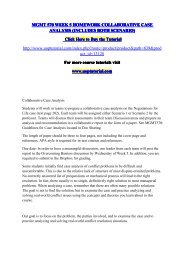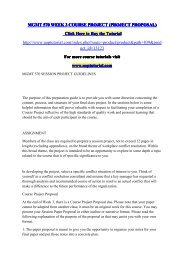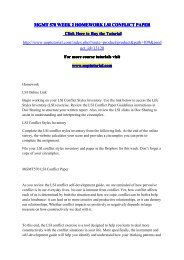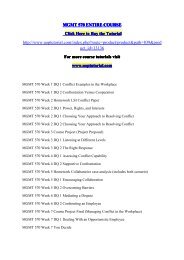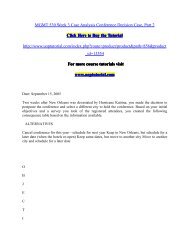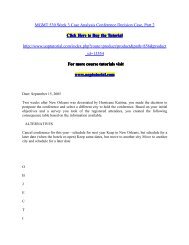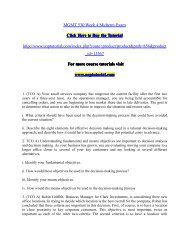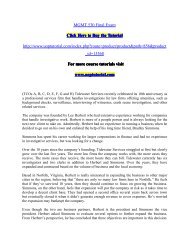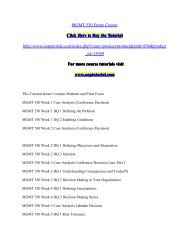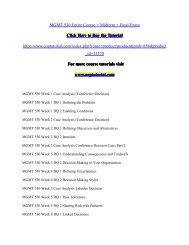MGMT 530 Week 7 Course Project (US Foods)
- No tags were found...
Create successful ePaper yourself
Turn your PDF publications into a flip-book with our unique Google optimized e-Paper software.
<strong>MGMT</strong> <strong>530</strong> <strong>Week</strong> 7 <strong>Course</strong> <strong>Project</strong> (<strong>US</strong> <strong>Foods</strong>)<br />
Click Here to Buy the Tutorial<br />
http://www.uoptutorial.com/index.php?route=product/product&path=856&product<br />
_id=13564<br />
For more course tutorials visit<br />
www.uoptutorial.com<br />
Objectives<br />
The objective of the <strong>Course</strong> <strong>Project</strong> is to provide you with practice in creating, justifying, and<br />
explaining a decision-making proposal. All elements involved in the creation of this proposal,<br />
from problem definition through action plan, must be covered. Further, the proposal, as<br />
constructed, must meet the tests of any sound business plan, namely that it has specific and<br />
measurable goals and objectives, clearly defined activities, stipulated time frames during which<br />
those activities will take place, and clearly defined measurable outcomes.<br />
The subject matter of your paper should be business-oriented in nature and should avoid<br />
decisions that depend largely on intuition to solve.<br />
Although the length of the paper is not predetermined, a 10–15 page analysis, including data and<br />
appendices, is probably correct. You will also share a summary PowerPoint presentation with<br />
fellow students during the <strong>Week</strong> 6 Discussion.<br />
The Final <strong>Course</strong> <strong>Project</strong> Proposal with the PowerPoint presentation is due by the end of <strong>Week</strong> 7<br />
(graded).<br />
Required Outline<br />
The following outline is required for your <strong>Course</strong> <strong>Project</strong>.<br />
• Executive Summary (less than one page)<br />
This summary is a short, carefully worded description of the problem situation that identifies the<br />
recommended solution. A brief justification and explanation of the selection method is to be<br />
included, highlighting factors that contributed to selecting the recommended alternative.<br />
• Decision Problem Overview
Describe the nature and scope of the decision problem selected, its history together with causes,<br />
and the outcomes of any previous attempts to deal with it.<br />
In order to define the problem correctly, the following questions should be addressed.<br />
• What is the general nature of the problem?<br />
• What event triggered the situation?<br />
• Are we imposing any constraints on the situation?<br />
• What are the underlying elements of the problem?<br />
• Are there dependencies on other decisions?<br />
Briefly introduce the key decision elements—objectives, alternatives, consequences, and<br />
uncertainties; details are to be discussed in the following sections.<br />
• Objectives Statement<br />
Explain each objective in detail. Separate objectives into fundamental and means objectives. A<br />
minimum of three objectives is required.<br />
• Alternatives<br />
Describe each alternative, and explain how the alternatives differ from one another. A minimum<br />
of three alternatives is required.<br />
• Selection<br />
Describe the alternative recommended and why. Explain the tradeoffs you utilized or present a<br />
weighted scoring model. Explain why you feel that this report contains sufficient information to<br />
make a decision on the problem. Describe any additional information that would be useful to<br />
have.<br />
• Consequences<br />
Explain how you determined the values for each alternative and their corresponding objectives.<br />
Show your consequence table, either in this section or as an appendix. Include the bases for<br />
forecasts and any techniques or tools used to estimate consequences. Discuss the reliability of
your predictions. Indicate what events were considered to be uncertain, explain the probabilities<br />
of their occurrence, and what information you used to establish your confidence level in these<br />
probabilities. A minimum of two uncertainties is required for the paper.<br />
• Implementation, Monitoring, and Control<br />
This section contains a detailed implementation plan. There will be an explanation of how the<br />
recommended alternative will be implemented, resources dedicated to accomplishing it, and key<br />
individuals who will be responsible for the plan’s success. Details should be included on how the<br />
plan will be monitored, subsequent evaluation criteria, and how the plan can be amended.<br />
• Works Cited (at least two external sources should be used)<br />
Presentation<br />
Once you have outlined your paper, you should be ready to begin a PowerPoint presentation. As<br />
you develop the contents of the sections in your paper, you should extract bullet-point ideas that<br />
best express your intended message. If you prefer, use the slides to brainstorm and organize your<br />
thoughts before writing the paper. Then refer to your presentation to guide and remind you of the<br />
flow of your storyline.<br />
The presentation will be used to showcase your decision problem in one of the <strong>Week</strong> 6<br />
Discussion topics, where you will receive feedback from your fellow students. This exercise will<br />
assist you in finalizing your <strong>Course</strong> <strong>Project</strong> prior to submission at the end of <strong>Week</strong> 7.<br />
A recommended <strong>Course</strong> <strong>Project</strong> template can be found here . This document is also posted in the<br />
Doc Sharing tab.


